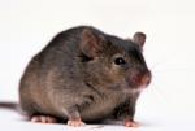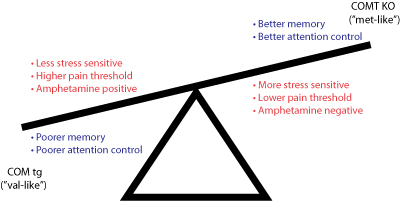Archived Content
The National Institute of Mental Health archives materials that are over 4 years old and no longer being updated. The content on this page is provided for historical reference purposes only and may not reflect current knowledge or information.
Gene Variants Force Mental Trade-offs: Efficiency vs. Resiliency
Mouse Genetic Models Hint at Why We Can’t Always Have It All
• Press Release

Mice engineered to express human gene variant
Mice genetically engineered to have an over active version of a human gene, like their human counterparts, gain in emotional mettle under stress, but at a cost of less efficient thinking, NIMH scientists have discovered. Such talents seesawed in mice engineered to have either too much or not enough the val version of the COMT gene, the most common of two that humans inherit. The new study in mice confirms and helps to explain the trade-offs seen in earlier studies in humans, which have suggested that the val version slightly biases the brain's workings toward increased risk for schizophrenia.
Francesco Papaleo, M.D., Daniel Weinberger, M.D., and colleagues in the NIMH Genes Cognition and Psychosis Program, report on their findings in The Journal of Neuroscience, August 27, 2008.
Mice with too much of the COMT val gene version faltered at attention and working memory tasks but seemed relatively unfazed by stress and pain. By contrast, mice lacking the gene showed better working memory but buckled under stress or pain. The stimulant amphetamine improved memory in mice with too much COMT val, whereas the drug impaired memory in normal mice. The researchers traced these effects to COMT action on a pivotal pathway in the brain's frontal lobe that has been linked to learning and memory.
"It makes sense that a gene version that has been conserved throughout the evolution of the human brain would confer some advantages and disadvantages," explained Weinberger. "We have now created strains of genetically engineered mice that reproduce virtually every feature associated with this variation in the COMT gene in humans, and pinpointed the brain pathway through which it exerts these effects."

Like a seesaw, each of two common versions of the COMT gene was associated with tradeoffs in the way the brain works. Mice in which the val version was knocked out (KO) showed traits associated with the met version — excelling at memory and attention tasks, but at a cost of being more susceptible to stress and pain. Transgenic (tg) mice in which the val version was over-expressed showed an opposite set of attributes.
References
Papaleo F, Crawley JN, Song J, Lipska BK, Pickel J, Weinberger DR, Chen J . Genetic dissection of the role of catechol-O-methyltransferase in cognition and stress reactivity in mice. J Neurosci. 2008 Aug 27;28(35):8709-23. PMID: 18753372
Mattay VS, Goldberg TE, Fera F, Hariri AR, Tessitore A, Egan MF, Kolachana B, Callicott JH, Weinberger DR . Catechol O-methyltransferase val158-met genotype and individual variation in the brain response to amphetamine. Proc Natl Acad Sci U S A. 2003 May 13;100(10):6186-91. Epub 2003 Apr 25. PMID: 12716966
